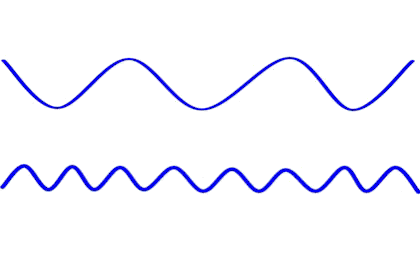


Vibrato is an integral part of beautiful flute playing. How do you go about learning how to play with vibrato?
 There are two parts to vibrato: speed
(how fast) and depth (amplitude). In order for vibrato to become a useful component of
your playing, you must learn to control both of these parameters. Try this experiment.
Place your hand over your solar plexus (just underneath the bottom of your
There are two parts to vibrato: speed
(how fast) and depth (amplitude). In order for vibrato to become a useful component of
your playing, you must learn to control both of these parameters. Try this experiment.
Place your hand over your solar plexus (just underneath the bottom of your ribcage) and
cough.
Did you feel the muscle of your upper abdomen contract? Now do the same thing without
engaging your throat in the exercise. It should sound like a forceful "Huh!" if you are doing it
correctly. You should feel those same muscles contract again. Now see if you can do a
number of
"Huh's" in a row like this:
Huh-uh-uh-uh-uh. Try it
slowly at first, then gradually speed it up.
Now it's time to experiment with your flute. First choose a note that is easy to play like a "B" in the middle of the staff. Play it with a full, steady sound. Make sure you are blowing evenly and steadily. No inadvertent wobbles! Listen carefully! Be absolutely certain that you can play with a strong and even air stream before you start learning vibrato. Otherwise you can make a bad situation worse. The basis for good vibrato is first learning to play with an even air stream. When you are confident that you are blowing evenly you can begin your exploration of vibrato.
 Set your metronome at about 60 bpm to start out. Marcel Moyse's famous tone exercise is
great to use for this practice. Start out by playing half notes, B to Bb (A#), using the
same kind of breath pulse we talked about above and pulse the air in eighth notes. When
you can progress all the way to the bottom of the flute, moving by half-step, pulsing in
eighth notes, try the same thing now pulsing in triplets. Next do the same thing pulsing
in sixteenth notes to the bottom and finally in quintuplets. After you have gotten
comfortable doing this through the low register of the flute, do the same thing through
the middle register and finally up through the third octave. Though you will never play
with a vibrato as slow as eighth notes, it is good practice in learning to control the
speed of your vibrato. Make sure your vibrato is very distinctly wavy whatever speed you
play with or register you are playing.
Set your metronome at about 60 bpm to start out. Marcel Moyse's famous tone exercise is
great to use for this practice. Start out by playing half notes, B to Bb (A#), using the
same kind of breath pulse we talked about above and pulse the air in eighth notes. When
you can progress all the way to the bottom of the flute, moving by half-step, pulsing in
eighth notes, try the same thing now pulsing in triplets. Next do the same thing pulsing
in sixteenth notes to the bottom and finally in quintuplets. After you have gotten
comfortable doing this through the low register of the flute, do the same thing through
the middle register and finally up through the third octave. Though you will never play
with a vibrato as slow as eighth notes, it is good practice in learning to control the
speed of your vibrato. Make sure your vibrato is very distinctly wavy whatever speed you
play with or register you are playing.
You may notice a distinct difference in how vibrato feels to produce in the different registers. The other thing that you may notice is that it takes much more air to play with vibrato than without. As you get better at playing with vibrato, you will not notice either of these phenomena as much. You will improve at taking in enough air and learning to ration it more efficiently as you get more proficient with vibrato.
 Where
does vibrato comes from in your body? This is a complex question for which there seems to
be no specific answer. Unlike string players who anyone can observe producing vibrato with
their left hand, a flutist's vibrato emanates from inside the body. Scientists have
demonstrated that many different muscle groups are involved including the diaphragm,
abdominal wall and throat. Unless you are interested in the specific physiology of flute
vibrato, it seems as if the specifics are not really necessary to understand as long as
the quality of the sound with vibrato is within some basic guidelines. Probably the most
important question you can ask yourself is whether your throat is open and the air stream
is moving freely while using vibrato? If you close off your throat while you are
generating vibrato, the result will be a so-called "nanny-goat" or "machine
gun" vibrato that is too fast and not much good for expressive purposes.
Where
does vibrato comes from in your body? This is a complex question for which there seems to
be no specific answer. Unlike string players who anyone can observe producing vibrato with
their left hand, a flutist's vibrato emanates from inside the body. Scientists have
demonstrated that many different muscle groups are involved including the diaphragm,
abdominal wall and throat. Unless you are interested in the specific physiology of flute
vibrato, it seems as if the specifics are not really necessary to understand as long as
the quality of the sound with vibrato is within some basic guidelines. Probably the most
important question you can ask yourself is whether your throat is open and the air stream
is moving freely while using vibrato? If you close off your throat while you are
generating vibrato, the result will be a so-called "nanny-goat" or "machine
gun" vibrato that is too fast and not much good for expressive purposes.
Click here to learn more about how to use vibrato.